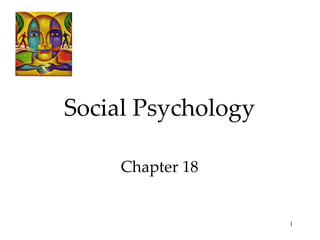
Chapter18
- 4. Focuses in Social Psychology Social psychology scientifically studies how we think about , influence , and relate to one another. “ We cannot live for ourselves alone.” Herman Melville
- 20. Group Pressure & Conformity Suggestibility is a subtle type of conformity, adjusting our behavior or thinking toward some group standard.
- 25. Informative Social Influence Baron et al., (1996)
- 26. Obedience People comply to social pressures. How would they respond to outright command? Stanley Milgram designed a study that investigates the effects of authority on obedience. Stanley Milgram (1933-1984) Courtesy of CUNY Graduate School and University Center
- 27. Milgram’s Study Both Photos: © 1965 By Stanley Miligram, from the film Obedience, dist. by Penn State, Media Sales
- 30. Lessons from the Conformity and Obedience Studies In both Ash's and Milgram's studies, participants were pressured to follow their standards and be responsive to others. In Milgram’s study, participants were torn between hearing the victims pleas and the experimenter’s orders.
- 51. Cognitive Roots of Prejudice In vivid cases such as the 9/11 attacks, terrorists can feed stereotypes or prejudices (terrorism). Most terrorists are non-Muslims.
- 54. Aggression Aggression can be any physical or verbal behavior intended to hurt or destroy. It may be done reactively out of hostility or proactively as a calculated means to an end. Research shows that aggressive behavior emerges from the interaction of biology and experience.
- 56. Influences Genetic Influences: Animals have been bred for aggressiveness for sport and at times for research. Twin studies show aggression may be genetic. In men, aggression is possibly linked to the Y chromosome. Neural Influences: Some centers in the brain, especially the limbic system (amygdala) and the frontal lobe, are intimately involved with aggression.
- 57. Influences Biochemical Influences: Animals with diminished amounts of testosterone (castration) become docile, and if injected with testosterone aggression increases. Prenatal exposure to testosterone also increases aggression in female hyenas.
- 59. Aversive Events Studies in which animals and humans experience unpleasant events reveal that those made miserable often make others miserable. Ron Artest (Pacers) attack on Detroit Pistons fans. Jeff Kowalsky/ EPA/ Landov
- 60. Environment Even environmental temperature can lead to aggressive acts. Murders and rapes increased with the temperature in Houston.
- 61. Frustration-Aggression Principle A principle in which frustration (caused by the blocking of an attempt to achieve a desired goal) creates anger, which can generate aggression.
- 62. Learning that Aggression is Rewarding When aggression leads to desired outcomes, one learns to be aggressive. This is shown in both animals and humans. Cultures that favor violence breed violence. Scotch-Irish settlers in the South had more violent tendencies than their Quaker Dutch counterparts in the Northeast of the US.
- 66. Summary
Hinweis der Redaktion
- OBJECTIVE 1 | Describe the three main focuses of social psychology.
- OBJECTIVE 2 | Contrast dispositional and situational attributions, and explain how the fundamental attribution error can affect our analysis of behavior.
- OBJECTIVE 3 | Define attitude.
- OBJECTIVE 4 | Describe the conditions under which attitudes can affect actions.
- OBJECTIVE 5 | Explain how the foot-in-the-door phenomenon, role-playing, and cognitive dissonance illustrate the influence of actions on attitudes.
- OBJECTIVE 6 | Describe the chameleon effect, and give an example of it.
- OBJECTIVE 7 | Discuss Asch’s experiments on conformity, and distinguish between normative and informational social influence.
- OBJECTIVE 8 | Describe Milgram’s experiments on obedience, and outline the conditions in which obedience was highest.
- OBJECTIVE 9 | Explain how the conformity and obedience studies can help us understand our susceptibility to social influence.
- OBJECTIVE 10 | Describe conditions in which the presence of others is likely to result in social facilitation, social loafing, or deindividuation.
- OBJECTIVE 11 | Discuss how group interaction can facilitate group polarization and groupthink.
- OBJECTIVE 12 | Identify the characteristic common to minority positions that sway majorities.
- OBJECTIVE 13 | Identify three components of prejudice.
- OBJECTIVE 14 | Contrast overt and subtle forms of prejudice, and give examples of each.
- OBJECTIVE 15 | Discuss the social factors that contribute to prejudice.
- OBJECTIVE 16 | Explain how Scapegoating illustrates the emotional component of prejudice.
- OBJECTIVE 17 | Cite four ways that cognitive processes help create and maintain prejudice.
- OBJECTIVE 18 | Explain how psychology’s definition of aggression differs from everyday usage.
- OBJECTIVE 19 | Describe three levels of biological influences on aggression, and cite evidence for each level.
- OBJECTIVE 20 | Outline four psychological triggers of aggression.
- OBJECTIVE 21 | Discuss the effects of violent video games on social attitudes and behavior.
- OBJECTIVE 22 | Explain how social traps and mirror-image perceptions fuel social conflict.
- OBJECTIVE 23 | Describe the influence of proximity, physical attractiveness, and similarity on interpersonal attractions.
- OBJECTIVE 24 | Describe the effect of physical arousal on passionate love, and identify two predictors of enduring companionate love.
- OBJECTIVE 25 | Define altruism , and give an example.
- OBJECTIVE 26 | Describe the steps in the decision-making process involved in bystander intervention.
- OBJECTIVE 27 | Explain altruistic behavior from the perspective of social exchange theory and social norms.
- OBJECTIVE 28 | Discuss effective ways of encouraging peaceful cooperation and reducing social conflict.